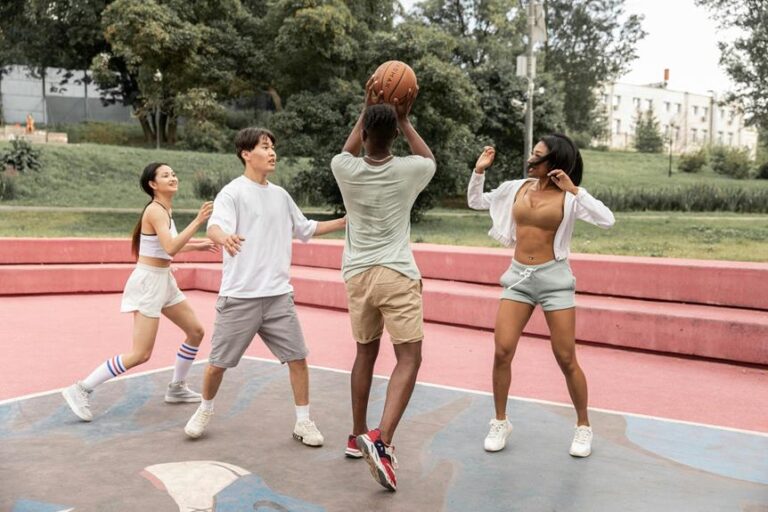Why Do Some Dunk Height Predictions Vary?
When determining why some dunk height predictions vary, crucial factors such as muscle power, approach speed, environmental conditions, and individual characteristics heavily impact the outcome.
Men typically possess higher vertical leap capacities due to strength and speed disparities, while younger individuals generally showcase greater jump potential compared to aging individuals facing muscle mass loss impacting jump performance.
Tailoring training, understanding sport-specific requirements, and balancing body composition are key to optimizing dunking abilities according to individual needs.
Scrutinizing these elements thoroughly sheds light on the various reasons behind differing dunk height predictions.
Key Takeaways
- Variability in muscle power and explosiveness affects jump height predictions.
- Differences in approach speed and jump timing lead to varied dunk forecasts.
- Environmental factors like surface traction and air resistance contribute to height variations.
- Individual factors such as body composition and tendon stiffness play a role in dunk predictions.
- Training intensity, consistency, and technique influence the accuracy of dunk height forecasts.
Factors Impacting Dunk Height Predictions
Understanding the various factors that impact dunk height predictions is essential for improving your performance on the basketball court.
Factors influencing vertical jump height are critical in determining how high you can soar for that epic dunk. Your muscle power, explosiveness, and coordination all come into play when trying to generate the lift needed for a successful dunk.
Additionally, variations in approach speed, takeoff angle, and jump timing can greatly affect the height you reach. Consider environmental factors such as surface traction, shoe grip, and air resistance, as they can also impact your dunking abilities.
Gender Differences in Dunk Predictions
When contrasting dunk predictions between genders, men generally outperform women due to disparities in muscle mass, power, and explosiveness.
Here are some key points to contemplate regarding gender differences in dunk predictions:
- Men typically have higher vertical leap capacities than women, contributing to increased dunk heights.
- Gender variations in dunk predictions are influenced by physiological differences in strength and speed.
- Biomechanical factors often result in higher average dunk height predictions for males compared to females.
- Tailoring training programs to address gender-specific disparities can help individuals optimize their vertical jump performance.
Age-Related Variations in Dunk Forecasts
As individuals age, their dunk height predictions tend to shift due to changes in physical capabilities and muscle strength. Younger individuals typically exhibit higher jump potential, resulting in more important dunk forecasts compared to older individuals.
Aging can impact jump performance by affecting the ability to generate enough lift for successful dunks.
Factors such as muscle mass loss, decreased explosiveness, and reduced vertical leap contribute to these age-related variations in dunk predictions.
Understanding these age-related changes is essential in tailoring training programs to enhance vertical jumps and dunking abilities.
By focusing on improving strength, explosiveness, and vertical jumps through targeted exercises, individuals can work towards maintaining or even enhancing their dunking capabilities as they age.
Influence of Training on Dunk Predictions
Incorporating specialized training routines can greatly impact the accuracy of dunk height predictions for athletes looking to enhance their vertical jump abilities. Here are four key points to take into account:
- Intensive plyometric training can boost your vertical jump height by 8-12%, providing a significant advantage when aiming for higher dunks.
- Focusing on strength training for muscles like quads, hamstrings, and calves directly influences your dunking ability, helping you achieve greater heights.
- Emphasizing proper technique and form during training sessions not only reduces the risk of injury but also contributes to more precise dunk height predictions.
- Consistent practice and progressively overloading your training can enhance explosiveness and power, essential for achieving those impressive high jumps.
Genetic Factors Affecting Dunk Height
Genetic factors play a significant role in determining an individual’s vertical jump height for dunking.
Various genetic components, such as muscle fiber composition, tendon stiffness, testosterone levels, bone structure, and energy system efficiency, influence your ability to jump effectively. Here’s a table summarizing genetic factors affecting dunking potential:
| Genetic Factor | Impact on Dunking Height |
|---|---|
| Muscle Fiber Composition | Determines explosiveness for generating vertical lift |
| Testosterone Levels | Influences muscle mass and strength for powerful jumps |
| Bone Structure and Angles | Affects biomechanics and leverage for vertical lift |
Understanding these genetic factors can help you optimize training strategies to improve your vertical jump height for dunking.
Body Compositions Role in Dunk Forecasts
Body composition plays a vital role in determining an individual’s potential dunking ability by influencing muscle mass and power-to-weight ratios.
Here are four key points to keep in mind:
- Muscular individuals with lower body fat percentages tend to have better power-to-weight ratios, essential for achieving higher jumps.
- Higher muscle mass, especially in the lower body, enables individuals to generate more force for impressive vertical leaps.
- Body composition plays a substantial role in strength, explosiveness, and overall athleticism, essential factors in dunking potential.
- Maintaining a balanced body composition through proper training and nutrition can optimize performance, increasing the likelihood of reaching desired dunking heights. Remember, your body composition can be a game-changer when it comes to maximizing your vertical leap and dunking capabilities.
Specific Sport Requirements for Dunking
Understanding the specific vertical jump requirements for different sports is essential for setting realistic dunking goals and optimizing your training regimen.
Each sport has its own unique demands when it comes to achieving a successful dunk. Below is a table outlining the sport-specific requirements for dunking in basketball, volleyball, and track and field high jump events, considering the necessary vertical jump heights for each.
By recognizing these variations, you can tailor your training to meet the specific needs of your sport and work towards improving your vertical jump to meet dunking goals effectively.
| Sport | Vertical Jump Requirement |
|---|---|
| Basketball | 28-34 inches for males, 24-30 inches for females |
| Volleyball | 20-24 inches |
| Track and Field | Varies based on event |
Individual Differences in Dunk Predictions
To explore the factors influencing individual differences in dunk predictions, consider how muscle power, jump technique, and explosiveness can all play a significant role.
Here are four key aspects to keep in mind:
- Body Composition: Variances in muscle mass and fat percentage can impact one’s ability to jump vertically.
- Muscle Fiber Types: Different types of muscle fibers can affect how efficiently muscles generate power for a jump.
- Tendon Stiffness: The flexibility and stiffness of tendons can influence the force generated during a jump, affecting the height reached.
- Psychological Factors: Confidence, focus, and motivation can directly impact an individual’s standing reach and their ability to jump vertically.
Understanding these factors can shed light on why dunk height predictions vary among athletes.
Training Intensitys Impact on Dunk Height
Increasing training intensity has a significant impact on dunk height potential, leading to higher vertical jump heights for successful dunks.
By integrating plyometrics and strength exercises into your routine, you can enhance your explosiveness and power, ultimately improving your vertical jump for dunking.
Consistent and vital training programs play an important role in maximizing your ability to reach greater heights during dunks.
Monitoring your progress and adjusting the intensity of your training based on your individual goals is imperative.
Research has shown a direct correlation between training intensity levels and the resulting increase in vertical jump height specifically for dunking.
By focusing on increasing your training intensity in a structured manner, you can unleash your full potential and elevate your dunking performance to new heights.
Frequently Asked Questions
At What Height Are You Expected to Dunk?
You are expected to dunk at a height that typically ranges from 28 to 34 inches. Your approach speed, takeoff technique, and vertical leap power all play a role in determining the height required for you to successfully dunk a basketball.
Can a 5 Foot 11 Person Dunk?
Sure, you can dunk at 5 foot 11 with dedication, practice, and explosive power. Perfecting your form, technique, and strength will help you soar to new heights. Keep pushing yourself to reach your dunking goals!
Can You Dunk at 6 5?
Yes, you can dunk at 6’5′ with the right vertical leap and skills. Your standing reach, jump height, and arm length are important. Training and genetics also play a part. Dunk predictions vary due to individual differences in technique and athleticism.
Can You Dunk at 177 Cm?
You can dunk at 177 cm with practice and dedication. Elevate your vertical jump through focused training. Technique, explosiveness, and athleticism matter. Believe in your ability to soar higher and aim for that slam dunk!
Conclusion
To sum up, dunk height predictions can vary due to a combination of factors such as gender, age, training, genetics, body composition, sport requirements, and individual differences.
It’s like trying to predict the weather – a mix of different elements coming together to create a unique outcome each time.
By understanding these factors and how they influence dunking abilities, you can better tailor your training and preparation to reach new heights in your dunking performance.













